A Surfing Way of Life
The culture that defines a way of life in Gisborne.
Written for Beachlife magazine in 2008
Much of this feature story was written for the second issue of Beachlife magazine in the summer of 2008-2009. It used material from the research of the subject that I had been gathering for 40 years or more, including a feature published in the Gisborne Herald in the 1980s. That article used original material from interviews I recorded with key surf culture figures for a radio documentary broadcast on Radio 2ZG around 1975.

1960s surfers Mike Comber and Wayne Parkes share a wave during an early surfing contest at Makorori.
We live in a surfer’s mecca. That’s no exaggeration. The beaches of Gisborne, including Makorori and Wainui, are world-famous for their consistency and quality of surf. A large proportion of people who live in our community would define themselves as “surfers”. The activity of surfing and the culture that parallels the sport continue to have a huge influence on the social and political dynamic of our community. So many of our residents came here primarily to be close to the breaking surf, and there evolved a sense of an extended surfing family. This almost tribal sense of belonging has become more entrenched as a second and even a third generation of locals grows up to populate our surf breaks. In this article, we look at the history of surfing at our beaches and philosophise on the effects the "surfing way of life" has on how we view ourselves.
In researching the history of surfing in Gisborne all roads lead to one name – Kevin Pritchard. A local high school boy and a Midway surf clubby, he and a group of contemporaries can claim to be the first Gisborne surfers of the modern era – and the first to surf the waves at all of the local beaches. Folklore dictates that Pritchard was the first person ever to paddle out and catch a wave at Makorori Point and also Tuamotu Island.
Now 68 (at the time he was interviewed in 2008), and living at Papamoa, Pritchard can’t remember the exact date. It was probably 1961: “I was out there with a few others, but I know I was the first to paddle out and ride a wave that day. The others then joined me. I think I was with Dave Swann, Darryl Heighway, Peter Goodwin, John Logan.
“We were looking for new places to surf. We would go out to Sponge Bay and Wainui looking for decent shaped waves. That’s how we first got to Makorori. We used to surf Wainui a bit, but if Makorori was rideable it was better because we could get longer rides.”
It was only a year or so earlier in 1959 that Gisborne was introduced to surfing waves on stand up boards – as opposed to riding them on paddle skis – when a group of Piha clubbies brought what they called “zip boards” to a life saving carnival at Waikanae Beach.
Early surfer John Logan who was there at the time and now lives overlooking Wainui Beach in Wairere Road says: “Some guys from Piha brought these fibreglass boards down here, we called them “zip boards”. We had only ever ridden waves on surf skis but these guys were standing up on boards and riding sideways, across the waves.”
The “zip boards” were probably the very early surfboards made by pioneer Piha boardmaker Peter Byers, who had been inspired by watching visiting Americans Bing Copeland and Rick Stoner surf Piha in the late ‘50s.
Logan says the sport in Gisborne developed slowly from there and it was probably a year later that a tight group sat warily watching the waves at Makorori before Kevin Pritchard plucked up the courage to be first to venture out over the rocks to the Point.
Peter “Goody” Goodwin, who was there that day, was the junior member of the gang. He says Pritchard was the big guy, the leader of the pack. He would surf any size wave. On big days he would jump off the Gisborne breakwater, paddle across to Midway Beach and catch huge waves out by the “one mile buoy”.
Kevin Pritchard says: “Once we discovered Makorori we would always try to get out there. We used to spend all day, summer and winter, hanging out at Makorori. We didn’t have wet suits, maybe football jerseys i

John Logan, Peter Goodwin, Darryl Heighway, David Swann and Kevin Pritchard with the boards stacked on John’s Ford Anglia in 1962.

One of the most influential early Aussies in the Gisborne scene was surfboard maker Bob Davie who arrived from Sydney via Auckland around 1964.
In isolation this embryonic group of watermen were laying the foundations of a way of life and a code of behaviour that was to later become a unique lifestyle with a global following, it was the beginning of “surf culture” as it is known today.
An event that subtly changed the direction of surfing locally was the arrival in town in 1961 of the Bruce Brown surf movie “Surfing Hollow Days”. For the first time the locals saw the state of surfing as it was in California and a certain Malibu-cool style crept into the local scene. It also shifted surfing a step away from the hitherto surf life saving culture it had evolved from.
Peter Goodwin was possibly the first local surfer to interpret the messages filtering in from California and Australia. John Logan says: “Goody was the first of us to start moving his board around the wave, perfecting what was then called ‘hot-dogging’.”
The arrival of a wave of Australians with their flamboyant surfing styles and equally flamboyant social behaviour continued to fracture the early symbiosis between surf life saving and surfing. “Wild behaviour” became de rigueur, along with the radical new concept of “dropping out” to totally devote one's life to surfing. The Australians also introduced new moves and new surfboard shapes. All of the above was eagerly soaked up by the Gisborne locals.
One of the most influential early Aussies in the Gisborne scene was surfboard maker Bob Davie who arrived from Sydney via Auckland around 1964 with side-kick Bob “Arab” Steel. They liked the Gisborne lifestyle and the consistently good waves “up the coast”, and here Davie established the now legendary Bob Davie Surfboards. The man they later called the inventor of the shortboard, Bob McTavish, visited around this time and spent a few months shaping boards at the Stanley Road factory.
In the book “Gone Surfing: The Golden Days of Surfing in New Zealand” former New Zealand champion surfer, Alan Byrne says: “Bob was really important for surfing in New Zealand. He attracted a steady flow of top board builders and surfers to Gisborne such as Russell Hughes, Bob McTavish and Keith Paull.”
Bob McTavish told BeachLife: “I shaped for Bob Davie for three months in 1966. We surfed everywhere. The best were Pipeline, The Island, Makas, Mahia. My memories of that time are the pubs with the Maoris, huge flagons of beer, local wines and wonderful happy people. Surf, surf, surf and surf – and a new surfbreak around every corner. Unbeatable.”
Bob Davie departed from here to set up shop at Mount Maunganui in 1966, but he and the young shapers he attracted left behind a legacy of board making know-how and established Gisborne as a mecca for surfers from around the world. (Bob Davie died at his Whangamata home in March, 2017, aged 74.)

Australian surfer Bob 'Arab' Steele sets up for a tube ride at Makorori Beach in the summer of 1964.

The Australian invasion. A group of surfers stops for refreshments at the Ideal Dairy in Wainui Road on the way back to town from the coast.

Australian stylemaster Alan Dorman cut a swathe through the local scene in the mid-1960s.


Peter Goodwin has been credited with being the first Gisborne surfer to interpet the style of surfing seen in movies coming in from California in the early 1960s. Here he is captured during a classic hanging five moment on a small wave at Palm Beach, near Sydney, in 1966. Goody cranking a bottom turn at a local Gisborne break in the 1960s..

Bob Davie (second left) with a group of young local surfers including Roger Jenkins
and Terry Byrne during an early surfing contest at Midway Beach.

Barry Robinson, Denzil Owen, Howard Brangwyn, Alan Byrne, and Kevin Lewis.

A group heading for the surf pose for the Gisborne Herald's photographer including John Robinson, Mark Jones and Paul Conole.

Richard Smythe, Ian Steed and Terry Byrne warm up around a driftwood fire at Makorori Beach.

Locals Terry Byrne, Peter Goodwin and Roger Jenkins warm up
around a fire at Makorori Beach after a Gisborne Boardriders Club contest in 1964.
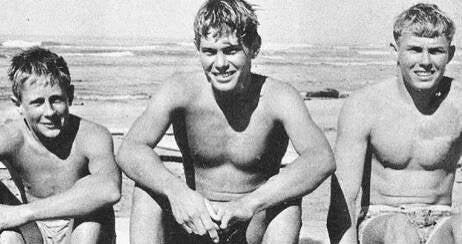
Allan Byrne, Glen Sutton and Ian 'Proto' Steed in 1965.

Local boy Roger Brown was Gisborne's answer to David Nuuhiwa.
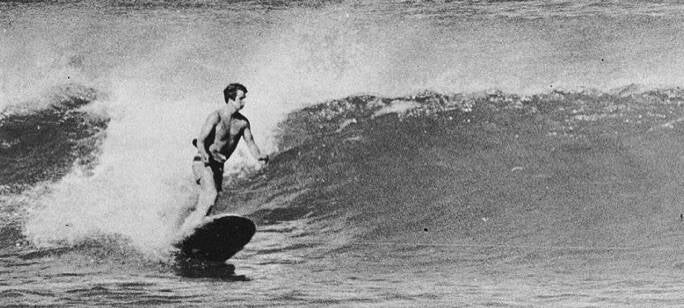
Gisborne local Denzil Owen surfs offshore Midway in 1966.

The history of surfing in Gisborne is not complete without mention of the Patty Twins,
Joan and Gail. Gail won the NZ Women's national surf title in 1967.
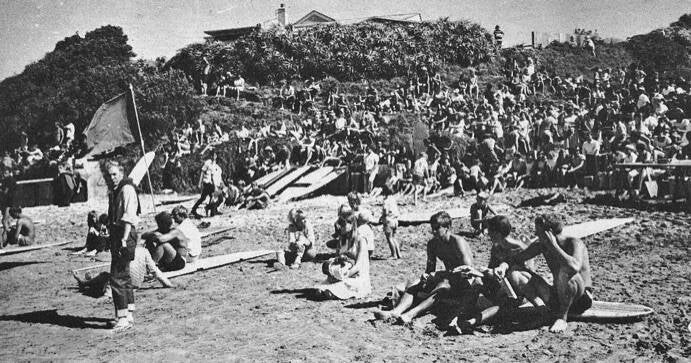
A huge crowd on the beach at the Stockroute for the 1966 National Championships in Gisborne.
In the mid 1960s, another Australian, Nigel Dwyer, turned up in town. He and his car load of Cronulla mates showed the locals how to surf and how to party Aussie style. He also did some glassing for Bob Davie before leaving to establish Del Surfboards in New Plymouth after the 1965 nationals. Davie says Dwyer was responsible for surfing being taken more seriously around Gisborne.
In April of 1968 two Australians turned up at the Makorori who were to have a huge impact on the evolution of local surfing.
Ben Hutchings and Bob Rasby – who had met in Byron Bay in ‘66 and had learned to make boards at Ken Adler’s San Juan surf shop – had earlier tossed a coin on the south side of the Bombay Hills to decide whether to go east to Gisborne or west to New Plymouth.
“Within a day of that fateful toss we were sitting under Makorori hill at end of the old dirt track with a light north-west wind and 6-foot plus north swell,” says Hutchings. “Centre, Red Bus and the Point were all going off. It was mid week, only two surfers out, Glen Sutton and Geoff Logan.
“I thought: Where are we? What is this place? Does anybody else surf here? Just a magic feeling. That little stretch of coastline from Stock Route to North Makorori — for atmosphere and vibe, matches anywhere in the world on its given day.
“I paddled over to the Inside Island with Russell Jones one day. There was a massive south swell, a light north-east wind, lines to the horizon. I looked at Russ and said this place will do me!”
Both Benny and Bob, in different stages, ended up staying in Gisborne for decades. Ben started a surfboard factory, they married local girls, had families here, saw in the era of the shortboard and stamped their marks permanently on the local surf culture. Bob Rasby’s story is told in more detail here.
In this way the world discovered Gisborne, and the ever-breaking waves at Wainui and Makorori beaches. And Gisborne discovered surfing at the same time. This was “Surf City”. For a time the town embraced the concept. Radio 2ZG became “Surf City Radio”, even the local car boys named themselves the “Surf City Hot Rod Club”.
As Hutchings and Jim Croskery and then Bob Rasby started shaping and glassing the first of thousands of locally-made surfboards, out of the city’s high schools emerged a new echelon of local surfers who were hell-bent on following the surfing way of life.
They were a hungry market for the designs of the shortboard revolution – at the same time absorbing a new lifestyle message filtering in from California. Local surfers, as did their contemporaries around the world, grew their hair long and warped the surfing lifestyle into a blend of California cool and Haight Ashbury mind expansion. This was most-often a pseudo-cosmic charade which advocated smoking marijuana and taking other mind-altering drugs, along with excessive alcohol consumption.
Most of the fathers, and many grand-fathers, of today’s grommets would have to admit to some degree of subscription to this psychedelic club. At one time during this period a tribe of local and foreign surfers set up a feral camp in the trees hidden from Highway 35 at Makorori Point and lived a semi-communal lifestyle close to the waves. The effect the large amounts of marijuana, first grown around Gisborne and later imported from Asia, had on the local surfing community is a story worthy of a separate feature. But not today.
To be fair, not all surfers indulged in this psychedelic binge beyond peer-pressure experimentation. While many “dropped out” and others were inspired to travel to exotic locations where the drugs were more accessible, there was a hard-core who continued to view surfing as an athletic watersport with which to hone their waterskills and train for physical fitness.
During this era many Gisborne-born surfers were also deciding Wainui Beach was the place to live. This writer included. First we found houses to rent and later were able to buy. Many is the story of the old beach house bought in 1980 for $30,000 which was recently priced at well over half a million (now up to $2 million) from surf bum to millionaire property owner is a familiar story.
There is also an underlayer of transplanted American’s who have quietly slipped into the Gisborne lifestyle.

Local surfers pose at Mount Maunganui after winning the 1967 Quane Trophy. From left – John Robinson, Greg Warren, Chris Ransley, Denzil Owen, Mark Jones, Glen Sutton, Billy Goodwin, Terry Burns, Peter Goodwin and Des Atkins.

Chris Ransley poses for the Photo News with his bag of trophies from the 1969 National Championships in New Plymouth, including the the Catalina Cup for the best overall surf rider, the Bob Davie Surfboards Trophy for the junior title, and the junior board riding title and junior paddle race.
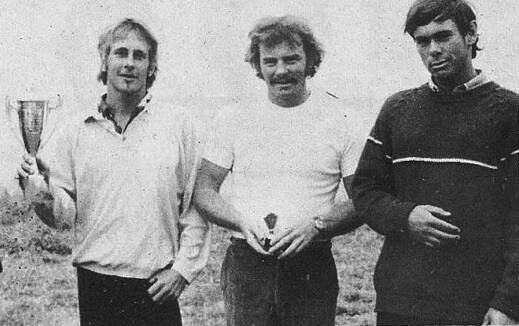
Allan Byrne, Benny Hutchings and Doug Hislop took the top honours at an invitational surfing event at Makoroi in 1969.

The Surfboards Gisborne factory in Disraeli Street in 1970. Pictured are Jim Croskery, Alan Higgins and Benny Hutchings.

Doug Stewart and Ralph Blake were the founders of New Wave Surfboards in 1979, along with Willy Rare.

Ray Dalton purchased Natural Flight from Des Delaney and renamed it Gisborne Surf Co, now known as The Boardroom. Right:

Des Delaney, a surfer from Auckland, married local girl Janice Aylward in 1972. One of Gisborne's surfing characters of the day, Terry Byrne, was his best man. Terry's wife Dianne was the bridesmaid.
In recent years, there has been a steady arrival of surfers from other parts of the world. Brazilians, Agentinians, and Uruquayans are finding the beaches and lifestyle here to their liking. Several English surfers have moved over from the UK, bought houses, and are having families.
If there is one family that epitomises the way surfing has evolved into a way of life in this community, it has to be the Quinns. The two Quinn boys, Jae and Maz, are both full-time surfing professionals earning an enviable living purely from the surf industry (at the time of writing). Dad Garry Quinn was one of those Wellingtonians who came north in the early ‘70s looking for warmer water and better waves.
With the kids growing up there was change in the wind in the surf scene. From the early ‘70s right through to the mid-’80s surfing was generally considered an “alternative” sport and the lifestyle surrounding it was most-often viewed by those who weren’t involved in it as rebellious, underground, unproductive – the pursuit of society’s dropouts. As Noel Craft said: “One day I was at the beach with a certain high school principal who said, ‘look at all those useless surfers out there waiting or their next free ride’.”
However, a sea-change was coming. In the late ‘80s and into ‘90s there came to surfing a move away from the anarcho-cosmic attitude that had been running strong for a very long time. A neo-conservatism, based on family values, crept in with the renaissance of surfing “clubs” and competitions. This new competitive era was embraced by many surfing families with young children keen to go surfing and surf competitively.
In the new millennium, it became obvious that most surfer kids were inheriting their parents’ waterskills and then some. Many kids were surfing almost as soon as they could stand up. Surfing became a children’s sports option. The Gisborne Boardriders Club was re-energized and very quickly warped from seedy, late-night booze cult into a family barbeque revival.
Surfing quickly become an acceptable, and sought-after, way of life – and a viable business. Many people have been and still are today involved in the surf industry in some way or other.
The revival of the longboard has allowed surfers to continue surfing past their body’s former use-by dates. As we speak, stand-up paddle surfboards prowl the line-ups, kite and foil surfers are pushing the boundaries of the possible. It’s very colourful and very healthy. And it’s still free. No one has yet come up with a concept to charge people for the use of the waves. The beaches and the waves still belong to all of us.
New Zealand's surf city has all the credentials

So why is Gisborne, of all the beaches, coves and bays on the coastline of New Zealand – so “surf special”? Why have so many people been drawn here from all points of the compass and never been able to leave?
The answer lies in the regularity of storm generated ocean swells and the prevailing wind direction in Gisborne. We have two surfing arenas side-by-side – the town and the coast – each providing rideable waves in a variety of geophysical, weather and swell direction scenarios.
Makorori is primarily a series of reef breaks. Makorori Point is a permanent reef structure, affected by the build up of sand along its edge. Surf quality depends on the direction of the swell, but it is a fairly predictable and constant option. Swells break on the point of the reef then slide along its shallow edge creating a surfable, breaking shoulder. It is the longest and often most gentle wave in the area. It can also be the most perfect when all factors are aligned. The rest of the popular breaks at Makorori are also created by permanent rock and reef structures, all dependent on random sand movement, but are generally consistent and permanent breaks.
Wainui Beach is a different scenario. Along its four kilometre sandy length are several named surf breaks, but the conditions that create them are random. Just off the beach in the wave breaking zone the sand is constantly moving, constantly shifting and shaping transient sandbanks. The sandbanks are shaped by the direction of offshore currents cutting channels in the sand. The currents are determined by the prevailing wind and swell directions. Wainui’s geographic position facing due east means that the bay is like a huge radar dish, attracting swell from due north right around the compass to due south. A 180° wave window!
Swells generated by Antarctic storms arrive here, so too do waves created by tropical cyclones near Fiji. The cream on the cake is the local prevailing wind direction – the offshore north-westerly. The same wind that brings cold Tasman rain and rough conditions from Auckland down to Wellington, blows itself dry over the Raukumara Ranges, absorbs the warmth of the Poverty Bay flats, fans out over Wainui and Makorori Beaches, brushing the incoming ocean swells smooth and glassy, clean and steep.
The only bugbear in this perfect surfing scenario is the equal prevalence of summer sea breezes turning the wind around each morning as the land heats up, sucking the cool ocean air back inland. This is why surfers place so much importance on getting up early and surfing the optimum conditions before the arrival of the mid-morning sea breeze.
The demanding nature of the beach breaks at Wainui – most often providing short, steep, cylindrical waves – has made it a nursery for many of New
Tragic end to the legend of Allan Byrne

Allan Byrne was the posterboy of the surfing culture of the 1960s and 70s, winning numerous local and national events. He is pictured here as the the star of the New Zealand Surfriding Championships held at Midway at Gisborne in 1967 . Winning every event he contested, the 16-year-old national junior champion was also awarded the Catalina Cup for the most outstanding surfer at the event.
Gisborne's surfing community was in shock in early August of 2013 at the news veteran surfer Allan Byrne, who grew up and sprang to national prominence in Gisborne, has died following a motorcycle accident in Bali.
The 62-year-old Australia-based surfer and board maker was holidaying in Indonesia and was due to compete in the Rip Curl Cup masters division that week. He was injured in a motorcycle crash and was taken to hospital with a broken arm. Doctors found he also had a fractured skull and bleeding on the brain. When Byrne slipped into a coma he was put on life support and never recovered.
Byrne had earlier survived open heart surgery and to celebrate his recovery he spent his 60th birthday surfing 40-foot waves in Hawaii.
"It's sad and everyone is devastated," surfing veteran Gail Patty told the NZ Herald. Patty who, along with Byrne and a number of other surfers from the 1960s, is one of Gisborne's surfing originals.
Allan Byrne grew up in Awapuni Road and attended Awapuni School, Gisborne Intermediate and Gisborne Boys' High.
Prominent in Gisborne and Hawke's Bay championship swimming events, and a member of the Waikanae Surf Life Saving Club, Byrne's first love became surfing after his father Des made surfboards for himself and his two sons Terry and Allan.
By the time he turned 16, Allan had already assembled an impressive surfing career. He first won the under-18 division of the nationals at Mount Maunganui in 1964, at the age of 13, the New Zealand junior board race trophy and the world paddle race trophy.
He also won the Catalina Cup for the most outstanding surfer at the New Zealand championships and finished fifth in the five-mile paddle race at the World Surfing Championships at Santiago.
He went on to win four under-18 and four open crowns. From 1966 to 1972, he competed in four world surfing championships and in 1981 he placed second in the Hawaiian Pipeline Masters.
When early surfboard maker Bob Davie moved to Gisborne and set up a factory, he took the young Allan Byrne under his wing and taught him how to shape surfboards.
Davie later moved his business to Mount Maunganui. The Byrne family followed him and Byrne's father was employed by the surfboard manufacturer as foreman.
In 1977, Byrne moved to the Gold Coast of Australia, where he established the Byrning Spears surfboard factory. He hand-shaped boards for the likes of Kelly Slater, Darrick Doerner and Mark Occhilupo during his 40 years in the trade.
The world-renowned surfboard maker pioneered the six-channel, pintail surfboard, a design feature he is said to have developed from aerodynamics learned during his time in the New Zealand Air Force.
Long-time family friend Catriona Hallas told the Brisbane Times newspaper "He was one of those all-round sweet, deeply spiritual people who was incredibly inspiring. He was a master – a master of his game. And for that he will be remembered as a huge inspiration to the whole industry and surfers far and wide."
Gold Coast Surf Industry Taskforce chairman John Neilsen said: "He was the most influential board shaper of the past 30 years and was revered around the world."
Allan Byrne rides a clean wave during a local contest at Midway Beach in 1966, a month before he travelled to California to compete at the World Surfing Championships.
Local waterman Allan Byrne was the posterboy of the surfing culture of the 1960s and 70s winning numerous local and national events. He is pictured here as the the star of the New Zealand Surfriding championships held at Midway in 1967 . Winning every event he contested, the 16-year-old national champion was also awarded the Catalina Cup for the most outstanding surfer at the championships.

14-year-old Allan Byrne, who had just become the New Zealand junior surfing champion, emerges from a mid-winter Gisborne Boardriders competion at Makorori Beach in 1964.

A young Allan Byrne with his mentor Bob Davie displaying the latest surfboard designs of the day in the 1960s.
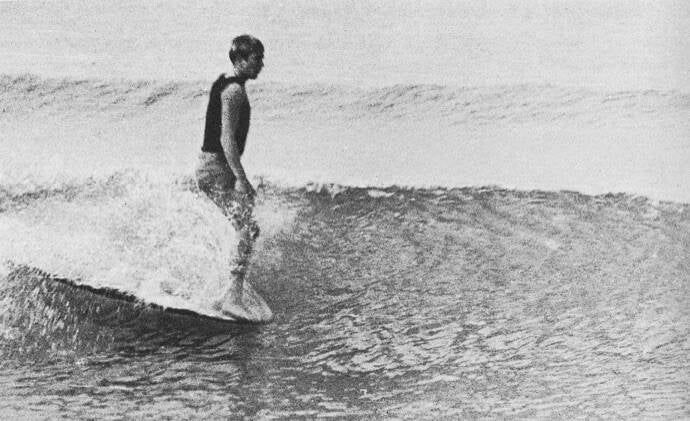
Allan Byrne rides a clean wave during a local contest at Midway Beach in 1966, a month before he travelled to California to compete at the World Surfing Championships. Left:

Allan Byrne and his signature backhand bottom turn.

Below: Allan Byrne surfs giant Pipeline during the 1981 Pipeline Masters.